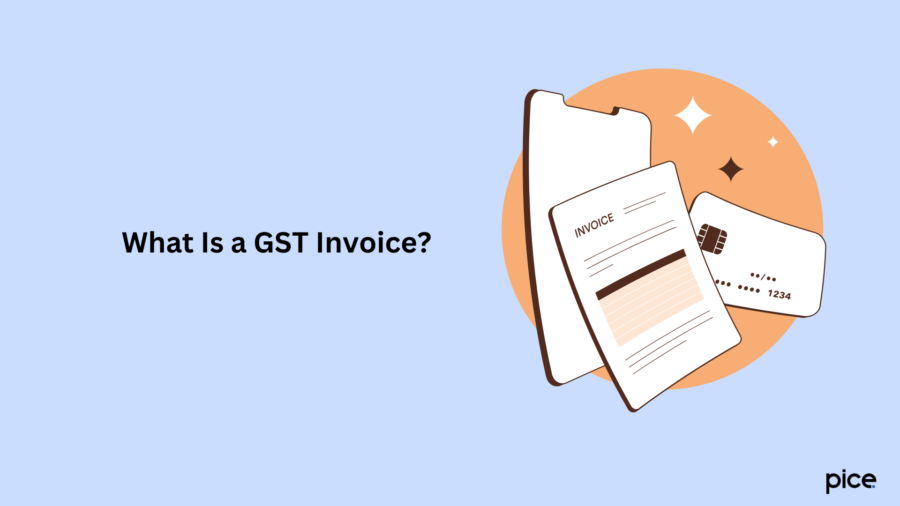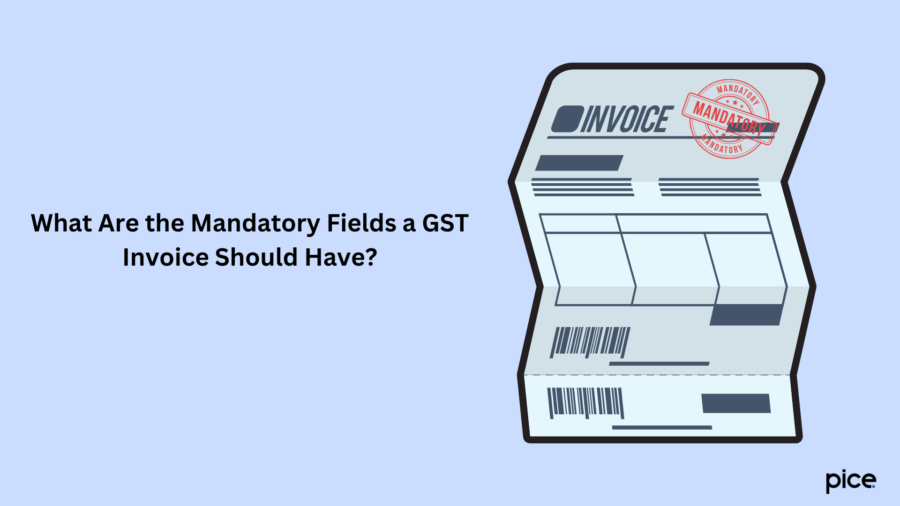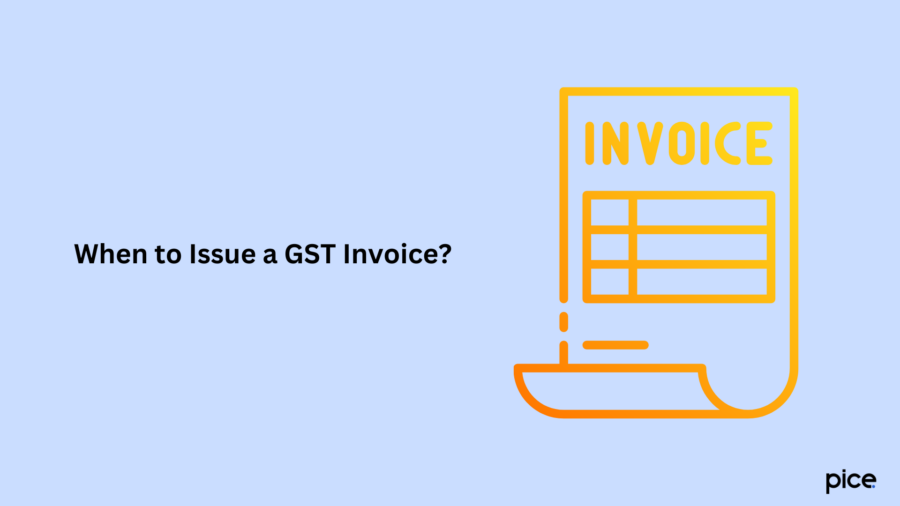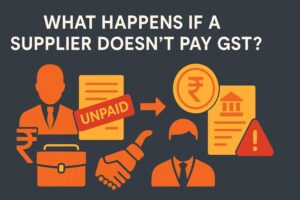What is GST Invoice?
- 22 Nov 24
- 15 mins

What is GST Invoice?
- What Is a GST Invoice?
- Who Should Issue GST Invoice?
- What Are the Types of GST Invoices?
- What Are the Mandatory Fields a GST Invoice Should Have?
- GST Bill Format
- How to Create a GST Invoice?
- What Common Errors Should You Avoid When Making a GST Invoice?
- When to Issue a GST Invoice?
- When is Issuing a GST Tax Invoice Not Mandatory?
- If an Invoice is Issued Before GST, Can It Be Revised?
- How Many Essential Copies for the GST Invoice Should Be Issued?
- Conclusion
Key Takeaways
- A GST invoice is essential for recording transactions and enabling Input Tax Credit (ITC) claims.
- Registered dealers must issue GST invoices for transactions above ₹200.
- Various GST invoice types ensure compliance for different transaction scenarios.
- Key details like GSTIN, HSN codes, and tax breakdown are mandatory on GST invoices.
- Non-compliance with GST invoice rules can result in steep penalties.
Understanding what a GST invoice is for registered dealers is crucial for operating under the new taxation system. It serves as a legal document of an exchange of either goods or services where details of the transaction are mentioned.
This document ensures correct computations of indirect taxes to be levied and consequently enhances transparency and business compliance in the taxation process. Let us go through this blog to dive deeper into the details of this tax invoice.
What Is a GST Invoice?

A GST invoice is a detailed record of a transaction between a seller and a buyer, outlining the products or services provided and the total amount due. This invoice provides structure, making it easier for customers to track their payments and any applicable deductions.
Sellers are required by law to issue GST invoices, especially for transactions above ₹200. To meet legal requirements, these invoices must be created as soon as the order is confirmed. This ensures clarity and helps customers easily follow their payments, fostering transparency in transactions.
For business entities, the GST invoice is very important as it allows to reclaim the Input Tax Credits which can offset the tax paid on the output supplied. If the amount of invoice is less than ₹2 lakh then it is mandatory for both the seller and the buyer to sign the invoices for authenticating the fact of the transaction. This documentation is very important because it gives affirmation of the sale and ensures all records done before payment are accurate.
Who Should Issue GST Invoice?
A registered taxpayer must issue a GST invoice, as it allows the buyer or recipient to claim input tax credit (ITC). While there is no mandatory format for the invoice, specific details must be included on the face of the document. Dealers who are not registered or those under the composition scheme must issue a Bill of Supply instead, as they are not permitted to provide a GST invoice to their customers.
What Are the Types of GST Invoices?
The GST system in India uses various types of invoices to address different transaction scenarios. Knowing these GST-compliant invoices is vital for businesses to ensure proper tax filing.
1. Bill of Supply
Business entities issue this type of invoice to supply goods or services that are exempted from GST. Registered suppliers also use this under the Composition Scheme. This tax invoice does not include GST. A registered supplier may issue a combined invoice and bill of supply when providing both taxable and exempt goods or services to an unregistered customer.
2. Aggregate Invoice
An Aggregate Invoice combines various sale of goods or services made to the same customer, especially when each individual's invoice is below a certain threshold. This helps streamline invoicing under GST and minimises paperwork. Aggregation is usually done for similar transactions occurring within the same state.
3. Credit Note
A credit note is used when the supplier has to change the amount of tax on a supply for example when goods are returned or when an error has been made on the original invoice. It is required when the original taxable value or the tax amount charged exceeds the correct amount that should have been applied.
4. Debit Note/Supplementary Invoice
This is issued to improve the taxable value of a given quantity of goods or services after an original invoice has been raised. This deals with issues of price change after sale, such as when a firm changes its prices or is correcting other errors. It is required where the initial taxable value and/or tax made were below the amount expected to be charged.
5. Reverse Charge Invoice
It is used when the tax responsibility shifts from the supplier to the recipient of goods or services, under the reverse charge mechanism. It must contain specific details like the supply nature, the tax payable and the reason to apply for a reverse charge. GST rules mention specific timelines to issue reverse charge invoices.
What Are the Mandatory Fields a GST Invoice Should Have?

To remain compliant with government regulations, you must maintain accurate records. Issuing a valid GST invoice helps avoid penalties. A GST invoice must include the following details:
- Customer’s name
- Unique invoice number and date
- Both shipping and billing addresses
- Place of supply
- GSTIN for both customer and taxpayer (if registered)
- Supplier’s signature
- Indication if GST is payable on a reverse charge basis
- Applicable tax rates and amounts, such as CGST, SGST or IGST
- Taxable value and any discounts
- Detailed description of items, including quantity, unit (such as meter or kg) and total value
- HSN or SAC codes
For unregistered recipients with invoices exceeding ₹50,000, additional details like the recipient's name, address, state name, state code and delivery address must be included.
Moreover, it is important to note that since 1st April 2021, HSN code reporting for business entities should be done in the following ways:
- Businesses with turnover above ₹5 crore must include a 6-digit HSN code on all invoices.
- If a business deals with B2B supplies and has an aggregated turnover of ₹5 crore or below, there is a 4-digit HSN code requirement. Reporting is optional for B2C invoices.
GST Bill Format
It must be noted that according to Section 2(66) of the Central Goods and Services Tax Act, 2017, Section 31 describes the essential parts of a viable tax invoice. While it gives an overall framework, it does not detail exact specifications or limit the use of manual invoices. GST invoices can be in both electronic and paper form, which has to meet the requirements laid out in Section 31.
How to Create a GST Invoice?
A GST invoice contains details of supply along with the taxes and discounts, if any. There are two possibilities for how you can generate GST invoices: by manual inputting or through invoicing software. Many accounting programs come with built-in invoice generation features. After entering the sales or outward supplies details, the software directly prepares, prints, and dispatches the invoice to the buyer.
Follow the below-mentioned step-by-step process to create a GST invoice:
STEP 1: Select the option ‘Invoice' (built-in every accounting/GST software)
In any accounting or GST software, choose the ‘Invoice’ option. If you have multiple branches, select the branch issuing the GST invoice. If there's only one, this step may be skipped.
STEP 2: Feed-in Date of Invoice
Input the date of the invoice. If the supply is made on a credit basis, you can also enter the payment date. For same-day payments, the invoice date and payment date will be the same.
STEP 3: Choose the Debtor or Customer from the List
A list of customers will be generated as per previous records and then one must choose the right buyer. If the customer details do not exist, you may need to use the ‘Create Debtor/Customer’ tab to input these details.
STEP 4: Choose the Place of Supply
This step is key to figuring out the right tax—whether it is IGST or CGST and SGST. Usually, the place of supply is based on the delivery or shipment address. If that's not available, the supplier’s registered state is taken as the place of supply.
STEP 5: Feed-in the Details of Goods or Services
Select the relevant goods or services from the drop-down list. If the list is not available initially, then there is an option to add new information through the ‘Create Item’ option. The CGST rate in the software shall be filled by default as per respectively with HSN/SAC codes. Then, mention the unit of quantity, discount if any and spot on the applicable rate whether IGST, CGST or SGST.
STEP 6: Click to Create GST Invoice
Once all the required information is entered, tap on the ‘Create GST Invoice.’ The invoice can be downloaded in Excel or PDF format and printed for distribution.
What Common Errors Should You Avoid When Making a GST Invoice?
Here are some common mistakes you should avoid when creating a GST invoice:
- Incomplete Details: Ensure that all required fields are properly filled in, such as the GSTIN, invoice number, date, recipient details, and a clear breakdown of the goods or services provided.
- Wrong GSTIN: Remember always to cross check the GST Identification Numbers ( GSTIN) of both the supplier and recipient. Issuing wrong GSTIN complicates input tax credit claims.
- Inconsistent Invoice Numbers : Maintain a unique and sequential numbering system for your invoices. Duplicate or mismatched invoice numbers can create confusion and lead to compliance issues.
- Mismatch Between Invoice and Supply Dates : Ensure that the invoice date corresponds with the supply date to avoid discrepancies, which could impact tax reporting and liabilities.
- Incorrect HSN or SAC Codes: Use the correct Harmonised System of Nomenclature (HSN) or Service Accounting Codes (SAC) to classify each item correctly for tax purposes.
- Errors in Calculation: Double-check calculations to avoid mistakes in taxable amounts, GST rates, and the total amount payable, as these errors can result in incorrect tax computations.
- Missing Reverse Charge Information: If the reverse charge mechanism applies, be sure to state them in the invoice as clearly as they could be. Missing out this leads to compliance problems.
- Inconsistent Invoice Format: It is good practice to have standard formatting for all invoices such that the user is able to decipher through each of the invoices easily.
- Omitting Place of Supply: The place of supply must be mentioned as it determines the applicable GST rate. Not including this information can lead to incorrect tax calculations.
- Issuing the Wrong Type of Invoice: Different situations require different types of invoices. Make sure to issue the appropriate type, whether it is a tax invoice or a bill of supply, based on the transaction type.
- Delays in Filing or Issuing: Follow the deadlines for filing GST returns and issuing invoices. Delays can lead to penalties and affect the recipient's ability to claim input tax credit.
- Non-Adherence to GST Regulations: It is important to familiarise yourself with the latest GST rules to avoid penalties, legal problems or losing input tax credit.
When to Issue a GST Invoice?

Issuance of GST invoices helps businesses maintain tax compliance, as it serves as formal evidence of the supply of goods or services. Both the supplier and recipient rely on this document to claim ITC.
Here are the different scenarios when you can issue a GST invoice:
- Issuing GST Invoice for Goods (Standard Supply)Under Section 2(96) of the CGST Act, suppliers generate an invoice on or before the goods are removed for supply. The term ‘removal’ can mean either when the goods are dispatched for delivery or when the recipient picks them up.
- Issuing GST Invoice for Continuous Supply of GoodsIn cases of continuous supply, suppliers must issue an invoice either before the account statement is generated or when payment is received—whichever happens first.
- Issuing GST Invoice for ServicesFor supply of services, the law requires the issuance of an invoice within 30 days after the completion of the service. Adhering to this deadline ensures that service recipients can claim ITC without any delay.
- Issuing GST Invoice for Banks and NBFCsBanks and Non-Banking Financial Companies (NBFCs) operate under a different timeline. They can issue GST invoices within 45 days.
When is Issuing a GST Tax Invoice Not Mandatory?
While issuing a GST tax invoice is generally required, there are certain circumstances where it is not mandatory:
- If the recipient of goods or services is not registered under GST, the supplier is not obligated to issue a tax invoice.
- If the recipient clearly states they do not need a tax invoice, the supplier may skip issuing one.
Both of these conditions must be met for the exemption to apply. If only one condition is fulfilled, the supplier must still provide a tax invoice.
On the other hand, registered suppliers may remit a consolidated tax invoice at the end of the day to all those unregistered customers who do not necessitate an invoice for their purchases. This method is permitted under the GST legal framework and the main purpose is to ease the complexity of issuing invoices, especially for small-value sales.
Suppliers must adhere to these rules to the letter to avoid falling foul of the law because any breakdown in GST invoice compliance can introduce fines and make it impossible to claim ITCs.
If an Invoice is Issued Before GST, Can It Be Revised?
Yes, you can revise an invoice issued before obtaining the GST registration. Businesses must know the correct way of modifying invoices to avoid mistakes on tax issues under the new GST laws.
Once a dealer receives their provisional GST registration, they must convert it into a permanent registration certificate. After receiving this certificate, they are given a specific timeframe, typically one month, to issue revised invoices for any transactions made before GST registration.
According to Rule 53 of the Central Goods and Services Tax (CGST) Act, 2017, revisions can be made to correct errors, adjust prices, or change GST rates. These adjustments can either increase or decrease the original invoice amount.
A revised GST invoice must include specific details, such as:
- Supplier’s name, address, and GSTIN.
- A unique serial number, limited to 16 characters, specific to the financial year.
- Date of the revised invoice.
- Recipient’s name, address, and GSTIN (if registered).
- Reference to the original invoice number and date.
- Signature or e-signature of the supplier or an authorised person.
How Many Essential Copies for the GST Invoice Should Be Issued?
When issuing a GST invoice, the number of copies required depends on whether the transaction involves goods or services.
- For Goods Supply: Under the GST system, three invoice copies of the goods which are used for transactions:
- Original Copy: This is given to the recipient of the goods and is required for them to claim Input Tax Credit (ITC).
- Duplicate Invoice: This goes to the transporter who delivers the goods. It ensures that the correct items are being transported and acts as verification.
- Triplicate Copy: Retained by the supplier, this copy is kept for accounting and tax purposes, providing evidence of the sale.
- For Services Supply: In service transactions, the process is more straightforward, requiring only two copies:
- Original Copy: Issued to the service recipient, it supports their accounting records and ITC claims.
- Duplicate Copy: Held by the service provider for record-keeping and tax compliance.
Since there is no physical movement of goods in service transactions, fewer copies are needed to manage the documentation process.
Conclusion
Now that you have understood what GST invoice is, businesses and individuals dealing with goods or services subject to GST must issue them correctly. They must stay informed about the different types of GST invoices and their specific requirements to ensure business compliance with GST rules.
Additionally, you must note that if an invoice is not issued there is a penalty and it lies at 100% of the tax due or ₹10,000 whichever is more. The penalty for issuance of an incorrect invoice is ₹25,000.
💡If you want to streamline your payment and make GST payments, consider using the PICE App. Explore the PICE App today and take your business to new heights
FAQs
What is a GST invoice, and why is it important?
What details are mandatory in a GST invoice?
Are businesses under the Composition Scheme required to issue GST invoices?
What are the different types of GST invoices?
Tax Invoice: For taxable goods and services.
Bill of Supply: For GST-exempt goods or Composition Scheme businesses.
Credit Note: Issued when tax charged is higher than applicable.
Debit Note: Issued to correct undercharged tax.
Reverse Charge Invoice: When tax liability shifts to the recipient.
 By
By 

















